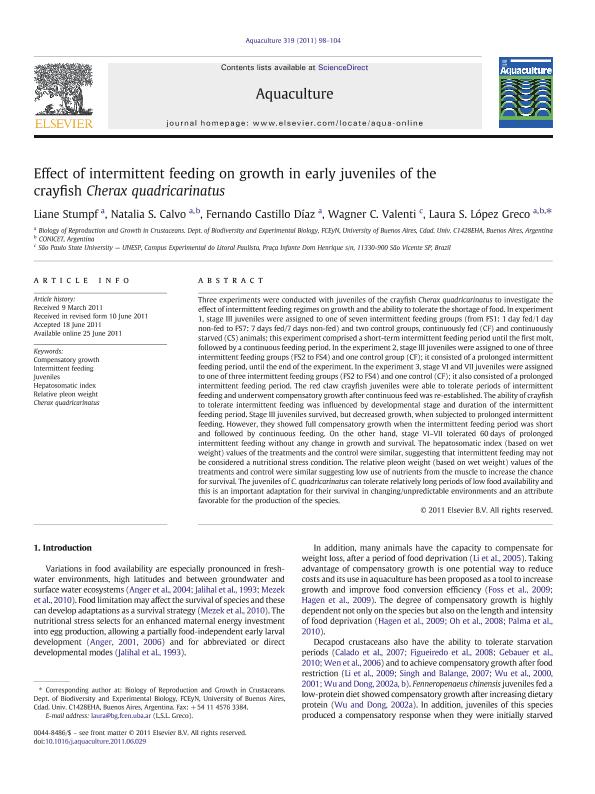Artículo
Effect of intermittent feeding on growth in early juveniles of the crayfish Cherax quadricarinatus
Stumpf, Liane ; Calvo, Natalia Soledad
; Calvo, Natalia Soledad ; Castillo Díaz, Fernando
; Castillo Díaz, Fernando ; Valenti, Wagner C.; Lopez, Laura Susana
; Valenti, Wagner C.; Lopez, Laura Susana
 ; Calvo, Natalia Soledad
; Calvo, Natalia Soledad ; Castillo Díaz, Fernando
; Castillo Díaz, Fernando ; Valenti, Wagner C.; Lopez, Laura Susana
; Valenti, Wagner C.; Lopez, Laura Susana
Fecha de publicación:
09/2011
Editorial:
Elsevier Science
Revista:
Aquaculture
ISSN:
0044-8486
Idioma:
Inglés
Tipo de recurso:
Artículo publicado
Clasificación temática:
Resumen
Three experiments were conducted with juveniles of the crayfish Cherax quadricarinatus to investigate the effect of intermittent feeding regimes on growth and the ability to tolerate the shortage of food. In experiment 1, stage III juveniles were assigned to one of seven intermittent feeding groups (from FS1: 1. day fed/1. day non-fed to FS7: 7. days fed/7. days non-fed) and two control groups, continuously fed (CF) and continuously starved (CS) animals; this experiment comprised a short-term intermittent feeding period until the first molt, followed by a continuous feeding period. In the experiment 2, stage III juveniles were assigned to one of three intermittent feeding groups (FS2 to FS4) and one control group (CF); it consisted of a prolonged intermittent feeding period, until the end of the experiment. In the experiment 3, stage VI and VII juveniles were assigned to one of three intermittent feeding groups (FS2 to FS4) and one control (CF); it also consisted of a prolonged intermittent feeding period. The red claw crayfish juveniles were able to tolerate periods of intermittent feeding and underwent compensatory growth after continuous feed was re-established. The ability of crayfish to tolerate intermittent feeding was influenced by developmental stage and duration of the intermittent feeding period. Stage III juveniles survived, but decreased growth, when subjected to prolonged intermittent feeding. However, they showed full compensatory growth when the intermittent feeding period was short and followed by continuous feeding. On the other hand, stage VI-VII tolerated 60. days of prolonged intermittent feeding without any change in growth and survival. The hepatosomatic index (based on wet weight) values of the treatments and the control were similar, suggesting that intermittent feeding may not be considered a nutritional stress condition. The relative pleon weight (based on wet weight) values of the treatments and control were similar suggesting low use of nutrients from the muscle to increase the chance for survival. The juveniles of C. quadricarinatus can tolerate relatively long periods of low food availability and this is an important adaptation for their survival in changing/unpredictable environments and an attribute favorable for the production of the species. © 2011 Elsevier B.V.
Archivos asociados
Licencia
Identificadores
Colecciones
Articulos(IBBEA)
Articulos de INSTITUTO DE BIODIVERSIDAD Y BIOLOGIA EXPERIMENTAL Y APLICADA
Articulos de INSTITUTO DE BIODIVERSIDAD Y BIOLOGIA EXPERIMENTAL Y APLICADA
Articulos(OCA CIUDAD UNIVERSITARIA)
Articulos de OFICINA DE COORDINACION ADMINISTRATIVA CIUDAD UNIVERSITARIA
Articulos de OFICINA DE COORDINACION ADMINISTRATIVA CIUDAD UNIVERSITARIA
Citación
Stumpf, Liane; Calvo, Natalia Soledad; Castillo Díaz, Fernando; Valenti, Wagner C.; Lopez, Laura Susana; Effect of intermittent feeding on growth in early juveniles of the crayfish Cherax quadricarinatus; Elsevier Science; Aquaculture; 319; 1-2; 9-2011; 98-104
Compartir
Altmétricas



